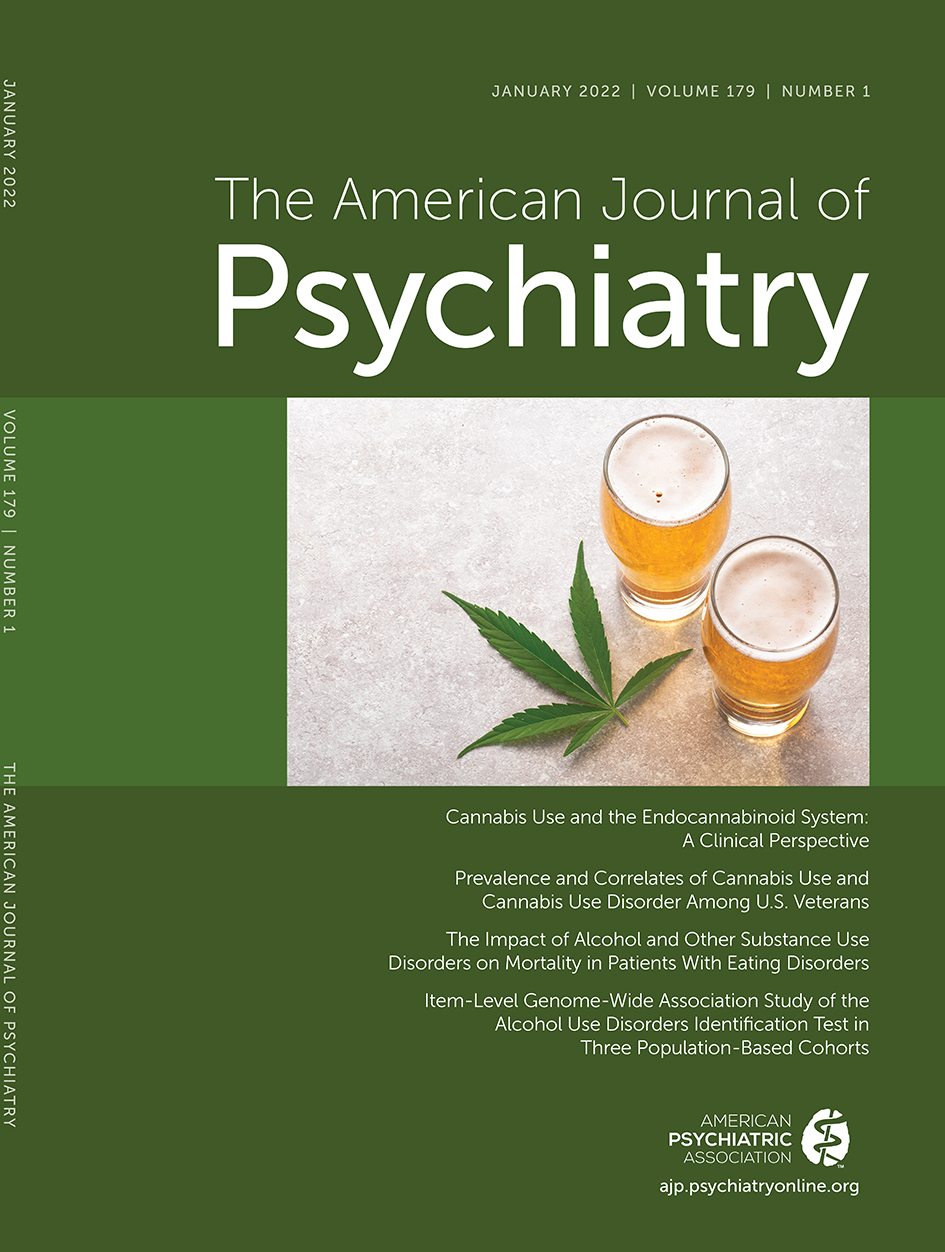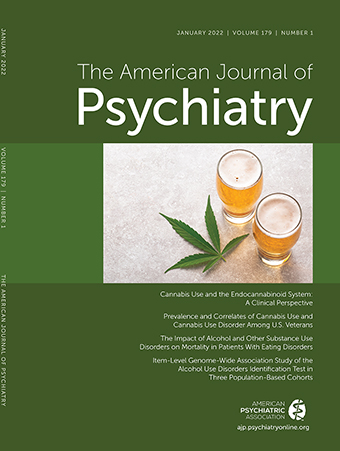Eating disorders (e.g., anorexia nervosa, bulimia nervosa) are associated with high premature mortality and are generally considered to be among the most lethal of all psychiatric disorders (
1). Similarly, mortality from substance use disorders has been well documented during the current drug overdose crisis in the United States (
2) and in numerous studies showing elevated death rates due to tobacco, alcohol, and other drugs (
3–
5). Yet, mortality from the combination of eating disorders and substance use disorders has infrequently been studied—a gap now addressed by Mellentin and colleagues, who document, in this issue of the
Journal, that the combined conditions are much more lethal than either disorder alone (
6).
Examining data from the Danish national registries, Mellentin et al. identified a large sample of patients with eating disorders (N=20,759) and compared them to a matched general population control group (N=83,036). Study subjects were 26 years of age or younger at baseline in 1994 and were followed until 2015. The mean follow-up time was similar between patients with eating disorders and their controls (11.0 years and 11.3 years, respectively), and the total person-years of follow-up was 227,538 for those with eating disorders and 939,628 for controls. Taking advantage of the large sample size, the authors were able to examine subgroups of persons with eating disorders (anorexia nervosa, bulimia nervosa, and unspecified eating disorders) and major substance use disorder categories (alcohol only; cannabis only; hard drugs only [i.e., heroin or other opioids, cocaine or other stimulants, sedatives, or other psychoactive substances; polydrug use was common]; alcohol and cannabis; alcohol and hard drugs; cannabis and hard drugs; and alcohol, cannabis, and hard drugs). Overall, the authors have provided an exceptionally detailed assessment of mortality risks for comorbid eating disorders and substance use disorders.
Of note, compared with matched control subjects without substance use disorders, the risk of all-cause mortality was 3.21 times higher (estimated as the adjusted hazard ratio) among patients with anorexia nervosa without substance use disorders, 11.28 times higher among patients with both anorexia nervosa and alcohol use disorder and/or cannabis use disorder, and 22.34 times higher among patients with both anorexia nervosa and a hard drug use disorder alone or in combination with alcohol use disorder and/or cannabis use disorder. For bulimia nervosa, all-cause mortality for those without substance use disorders was similar to their control counterparts, but the adjusted hazard ratio was 5.86 for those with comorbid alcohol and/or cannabis use disorder, and 11.43 for those with hard drug use disorder alone or in combination with alcohol use disorder and/or cannabis use disorder. For unspecified eating disorders, the adjusted hazard ratio was 4.75 for those without comorbid substance use disorders, 10.86 for those with comorbid alcohol and/or cannabis use disorder, and 15.53 for those with hard drug use disorder alone or in combination with alcohol use disorder and/or cannabis use disorder. Clearly, the combination of eating disorders with substance use disorders is associated with major increases in mortality (
6).
These important findings by Mellentin et al. suggest that attending to and addressing these co-occurring disorders is warranted for optimal clinical outcomes, especially because the combination of eating disorders with substance use disorders is frequent. A recent systematic review and meta-analysis by Bahji et al. (
7) highlighted the prevalence of substance use disorders among individuals with eating disorders. Among persons with eating disorders, the pooled lifetime and past-year prevalences of any comorbid substance use disorder are 21.9% and 7.7%, respectively. Perhaps not surprisingly, Bahji et al. found that tobacco use disorder (36.1%) and alcohol use disorder (20.6%) are the most prevalent lifetime substance use disorder comorbidities among persons with eating disorders.
In the study by Mellentin et al., tobacco use disorder was not specifically examined. Yet, tobacco is likely responsible for at least some of the increased mortality among those with substance use disorders, especially for internal (somatic) causes of death (
3). Mellentin et al. also were unable to consider socioeconomic characteristics and comorbid medical and other psychiatric conditions, which may be associated with eating disorders, substance use disorders, and mortality. In particular, socioeconomic disadvantages and early childhood adverse events may play a role in both substance use disorders and eating disorders and are themselves associated with poor overall physical, mental, and social health and premature death. Further work is needed to determine whether there may be common socioeconomic or developmental factors that contribute to mortality. The study also could not distinguish the specific substance use disorders in the “hard drugs” category, although polysubstance use is common among people with substance use disorders, and the specific substances involved may vary (
8). In addition, the study reported the percentages of certain specific cause-of-death categories among decedents with eating disorders and matched control subjects (e.g., substance use causes: 11.6% among decedents with eating disorders and 3.1% among matched control decedents; suicide: 24.8% among decedents with eating disorders and 14.6% among matched controls); however, adjusted hazard ratios for subtypes of eating disorders with and without substance use disorders are reported only for overall external (suicide, accidents, overdose, and homicide) and overall internal (somatic and psychiatric disorders) causes of death rather than for specific causes. Further work is needed to understand the specific overlap of eating disorders and substance use disorders with death by suicide and other specific causes.
The overlap between eating disorders and substance use disorders has been explained by shared biological (e.g., genetic), psychological, and sociocultural risk factors that increase predisposition to comorbid disease development and death (
7,
9–
14). Notably, both eating disorders and substance use disorders are associated with major depressive disorder, anxiety disorders, suicidality (suicidal ideation, suicide plan, suicide attempt, or death by suicide), impulsive behavior, and trauma and share emotional dysregulation that is intrinsic to psychopathology underlying a spectrum of psychiatric disorders (
7,
9,
10). For example, a meta-analysis of 36 studies found that 1 in 5 decedents with anorexia nervosa had committed suicide (
15). More research is needed to elucidate the mechanisms on how co-occurring eating disorders and substance use disorders lead to risk of mortality, particularly suicide deaths. Finally, the generalizability of the findings in the study by Mellentin et al. may be limited because the register data captured only treatment-seeking patients, who likely have more severe eating disorders, and patients with other severe psychiatric comorbidities.
Despite these limitations, the results of this longitudinal study are concerning and should inform clinical practice and public health efforts, in addition to inspiring additional research to understand mechanisms. The findings by Mellentin et al. represent an important step toward unpacking the extent of associations of co-occurring eating disorders and substance use disorders with excess mortality. Taken as a whole, the findings appear to underscore the importance of unified treatment approaches to addressing comorbid disorders simultaneously and consequently improving treatment outcomes.
Long-term recovery from eating disorders is associated with recovery from or absence of common major comorbidities such as substance use disorders. One recent 22-year longitudinal follow-up study found that, compared with patients who had not fully recovered from their eating disorders, those who had recovered were five times less likely to be diagnosed with substance use disorders in the past year (
11). The clinical implication of these results is that while receiving treatment for eating disorders, patients should be screened and offered treatment for substance use disorders. Indeed, people treated for eating disorders without receiving treatment for substance use disorders (or vice versa) appear to be at increased risk for symptom substitution (switching from one problematic behavior to the other), impeding their recovery and full remission (
9). If co-occurring substance use disorders are identified in persons with an eating disorder, residential eating disorder treatment has been suggested as an appropriate treatment choice to reduce morbidity and mortality (
12), and a promising approach is to use dialectical behavior therapy, which has been shown to be effective for treating comorbid alcohol use disorder, nicotine dependence, and eating disorders simultaneously, by focusing on improving emotion regulation and distress tolerance (
13).
In addition to the implications for clinicians caring for patients with eating disorders, the study by Mellentin et al. may also suggest the value in assessing for eating disorders in patients treated for a substance use disorder. The additive risk of death for both eating disorders and substance use disorders strongly suggests that persons with substance use disorders who are identified as having eating disorders are at increased risk of death. Eating disorder symptoms have also been found to be significantly associated with decisions to leave substance use treatment against medical advice (
14). Furthermore, a recent study (
13) found that individuals with lifetime alcohol use disorder and nicotine dependence have significantly greater risk of broad anorexia nervosa, purging disorder, and many eating disorder symptoms than people without the disorders, underscoring the importance of assessing eating disorder symptoms among people with alcohol use disorder who also smoke heavily, if not for all persons with substance use disorders.
Further research is needed to explicate the complex interrelationships of specific co-occurring eating disorders and specific substance use disorders with excess mortality, while adjusting for socioeconomic characteristics and comorbid medical and other psychiatric conditions. Moreover, research on the role of emotional regulation in children and their parents may contribute to new preventive strategies and treatment approaches for substance use (e.g., alcohol, tobacco, cannabis) and mental health problems (e.g., depression, anxiety, eating disorders). Longitudinal research such as the Adolescent Brain and Cognitive Development Study may provide just such data in the coming years (
16).
In summary, a major driver of mortality in patients with eating disorders is substance use disorders, which themselves are associated with high risk of mortality. Separately, eating disorders (either anorexia nervosa or unspecified eating disorders) and substance use disorders are each shown to be associated with high rates of mortality, but the combination of anorexia nervosa, bulimia nervosa, or unspecified eating disorders with a substance use disorder is particularly lethal because the risks of death from one are added to the other. Clinicians seeking to improve the prognosis of their patients with eating disorders need to attend to and address these deadly comorbidities.

